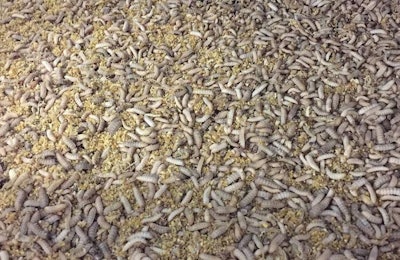
Research and approvals for insect meal use in animal feed have advanced quickly in recent years, but there are some myths surrounding the alternative ingredient.
Myth No. 1: Insects that feed on waste can spread disease
According to insect-based feed ingredient manufacturer Enterra, the adult black soldier fly does not eat, sting or bite, which means it’s not a pest or a vector for disease. All it does as an adult is mate and reproduce. The females lay eggs that hatch into larvae, which naturally feed on decaying organic matter.
As insects feed on waste, there may be concern over hygiene and the spread of disease. However, initial research suggests that insects pose less risk of transmitting zoonotic diseases than livestock species.
Enviroflight, a company that makes animal feed using black soldier fly larvae, says it follows the American Association of Feed Control Official (AAFCO) Guidelines, and does not use livestock manure as a feed source for its larvae, citing the potential of heavy metal contamination, Salmonella and other pathogens.
Myth No. 2: Insect meal diets have an adverse effect on chicken meat quality
Replacing half of the soybean meal in broiler diets with alternative protein sources had no adverse impacts on chicken meat quality, according to a study at the University of Göttingen in Germany. The pilot-scale study, published in the journal Foods, reveals that there were no quality issues with meat from chickens fed diets in which part of the soybean meal was replaced with alternative protein sources, reported lead author, Daniel Mörlein and co-authors at the Department of Animal Sciences.
Myth No. 3: Insect larvae depend on the same food sources as livestock
Insect larvae are less dependent on water and feed than fish and crops. According to the National Academy of Sciences and Science & Society, one-third of all cropland and 85 percent of global soybean production goes to feed livestock. The Food Agriculture Organization of the United Nations (FAO) says replacing fishmeal with insect protein could conserve 16 million tons of fish per year.
Enviroflight says it feeds its black soldier fly larvae a variety of materials including dried distillers grains with solubles (DDGS) from ethanol plants and brewer’s grains, cookie meal, and other organic materials available from pre-consumer processing.
Myth No. 4: Insect meal is a well-rounded ingredient
While insect meal is rich in protein (40 to 50 percent) with a greater concentration of essential amino acids than soybean meal, most insect meals are deficient in calcium, and its supplementation in the diet is required, especially for growing animals and laying hens. The levels of calcium and fatty acids in insect meals can be enhanced by manipulation of the substrate on which insects are reared.
According to the journal Animal Feed Science and Technology, unsaturated fatty acid concentrations are high in housefly maggot meal, mealworm and house cricket (60-70 percent), while their concentrations in black soldier fly larvae are lowest (19-37 percent). Except silkworm meal, other insect meals are deficient in methionine and lysine and their supplementation in the diet can enhance the performance of the animals and the soymeal and fishmeal replacement rates.
The metabolizable energy value of housefly maggots was evaluated in two trials (14.2 MJ/kg DM; 17.9 MJ/kg). Total tract amino acid digestibility is high, between 91 and 95 percent, but individual amino acid digestibility for poultry have yet to be determined.
Myth No. 5: Insect meal does not produce enough yield to be viable
Combined with potential production efficiencies, insect feed is attractive for the future of animal nutrition. For example, soybean yields around 0.9 metric tons (mt) per hectare (0.36 tons/acre) of protein, compared with insects that potentially yield 150 mt per hectare (60 tons/acre) protein. That offers the potential of a 200-fold reduction in land use.
According to the FAO, insects have a high food conversion rate: Crickets need six times less feed than cattle, four times less than sheep, and twice less than pigs and broiler chickens to produce the same amount of protein. They also emit less greenhouse gases and ammonia than conventional livestock. Insects can be grown on organic waste. Therefore, insects are a potential source for conventional production (mini-livestock) of protein, either for direct human consumption, or indirectly in recomposed foods (with extracted protein from insects); and as a protein source into feedstock mixtures.
















